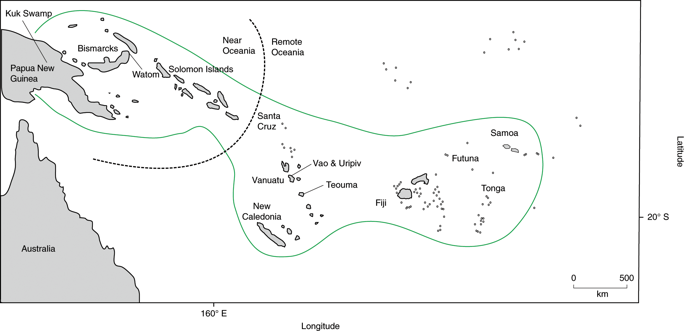Nature Human Behaviour ( IF 29.9 ) Pub Date : 2020-01-20 , DOI: 10.1038/s41562-019-0808-y Monica Tromp 1, 2, 3 , Elizabeth Matisoo-Smith 2 , Rebecca Kinaston 2 , Stuart Bedford 4, 5 , Matthew Spriggs 6 , Hallie Buckley 2

|
Remote Oceania, which largely consists of islands covered in tropical forests, was the last region on earth to be successfully colonized by humans, beginning 3,000 years ago. We examined human dental calculus from burials in an ancient Lapita culture cemetery to gain insight into the early settlement of this previously untouched tropical environment, specifically on the island of Efate in Vanuatu. Dental calculus is an ideal material to analyse questions of human and plant interactions due to the ingestion of plant-derived microparticles that become incorporated into the calculus as it forms throughout a person’s life. Most of the microparticles identified here are from tree and shrub resources, including a ~2,900 calibrated (cal) bp example of banana in Remote Oceania, providing direct evidence for the importance of forests and arboriculture during the settlement of Remote Oceania.
中文翻译:

古代大洋拉皮塔文化殖民者牙结石对热带雨林的开发利用
遥远的大洋洲主要由热带森林覆盖的岛屿组成,是地球上最后一个被人类成功殖民的地区,始于 3000 年前。我们检查了古代拉皮塔文化墓地墓葬中的人类牙结石,以深入了解这个以前未受破坏的热带环境的早期定居,特别是在瓦努阿图的埃法特岛。牙结石是分析人类和植物相互作用问题的理想材料,因为植物衍生的微粒会在人的一生中形成并结合到牙结石中。此处确定的大多数微粒来自树木和灌木资源,包括约 2,900 校准 (cal) bp 以偏远大洋洲的香蕉为例,为偏远大洋洲定居期间森林和树木栽培的重要性提供了直接证据。



























 京公网安备 11010802027423号
京公网安备 11010802027423号